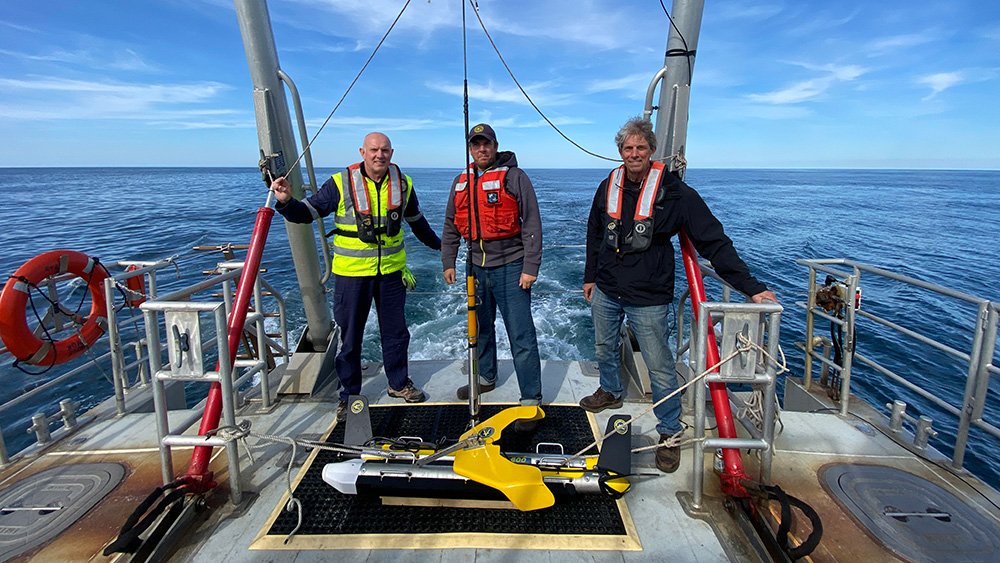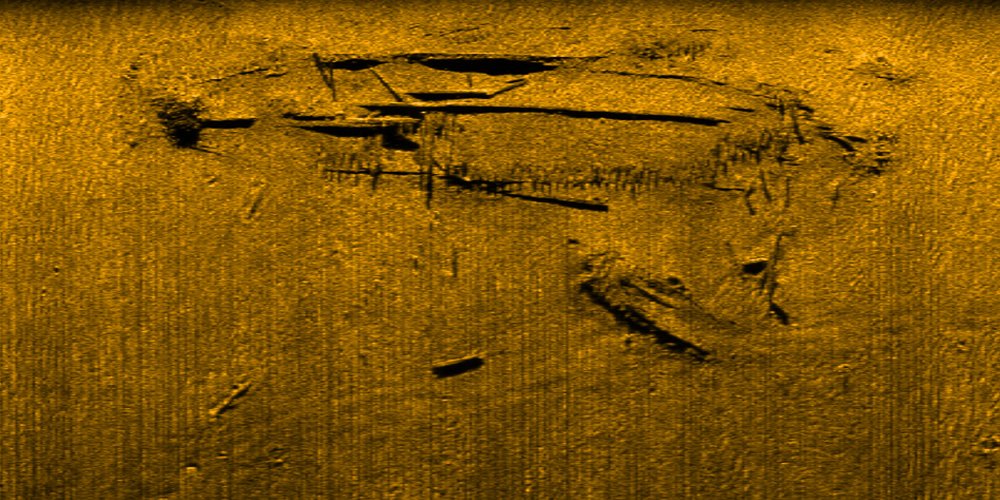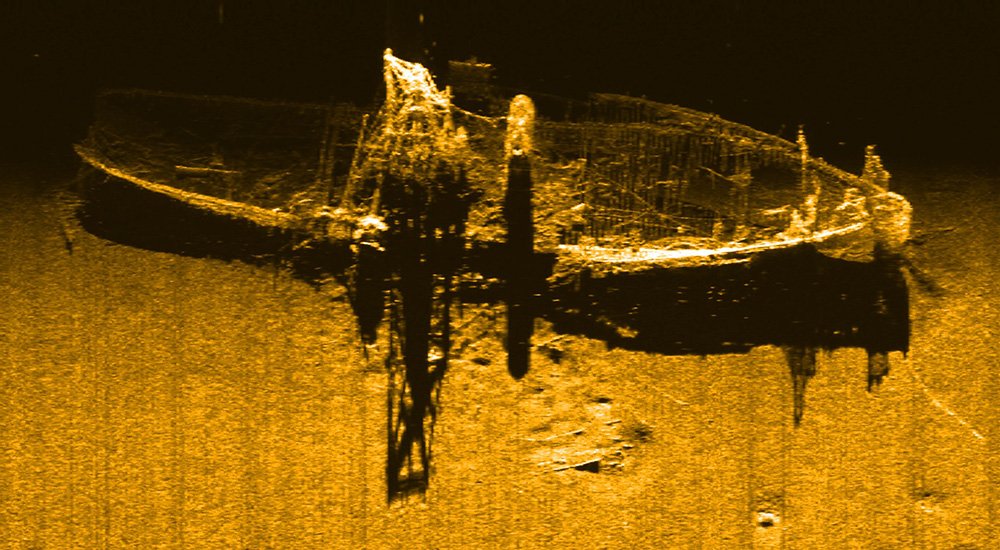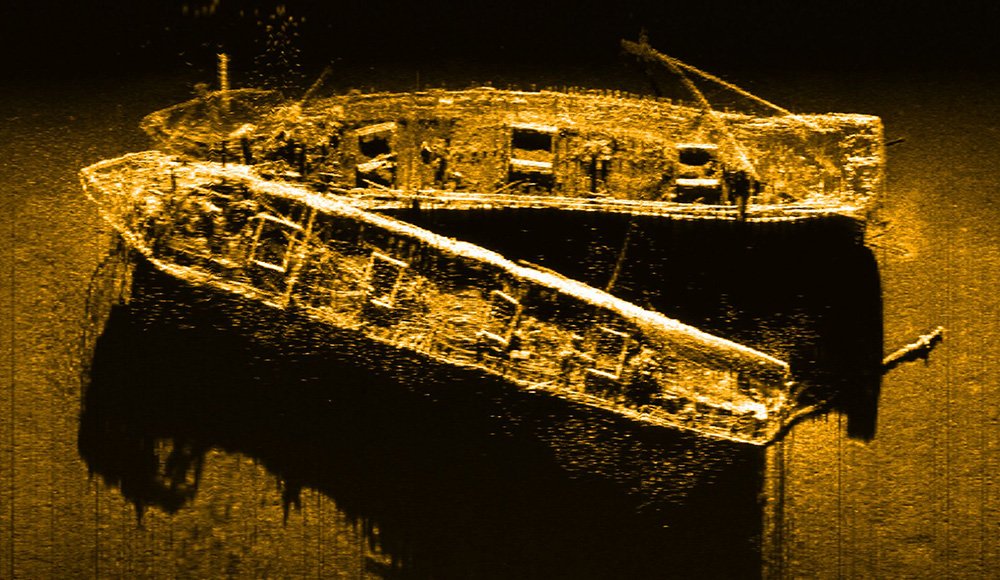Working Together to Unveil Sanctuary Seafloor Secrets
By Peyton Mills
December 2021

The study of Stellwagen Bank National Marine Sanctuary's maritime history has taken on new life with a recent public-private partnership that is providing sanctuary staff with unprecedented looks at historic shipwrecks.
Underwater archaeology involves painstaking, time-consuming, and costly work in a difficult environment. Over the past 20 years, intermittent missions have revealed several important finds, "but there's still much more left to be done," says Ben Haskell, deputy superintendent and maritime heritage coordinator. "The task is akin to finding a handful of individually-distinct needles in a haystack and describing each one in detail."
Advancing the sanctuary's efforts to better understand its maritime history, includes a recent collaboration with MIND Technology, Inc. and its newest Klein side scan sonar technology. Through this mutually beneficial partnership, sanctuary staff received highly detailed images of shipwrecks that provide clues to the effects of fishing and natural degradation on these maritime resources. Concurrently, MIND Technology was able to test prototype sonar systems and access real-world data that can be used to fine-tune the new technology.
Stellwagen Bank and Historic Preservation
As mandated by the National Historic Preservation Act (1966) and the National Marine Sanctuaries Act (1972), Stellwagen Bank National Marine Sanctuary is required to inventory and interpret its archaeological resources—an effort that began full-force in 1997, when a multi-beam survey conducted primarily by the U.S. Geological Survey aided the sanctuary in developing a list of target locations. However, it was often difficult to identify the object on the seafloor using the coarse resolution of multibeam sonar. This survey provided a serviceable baseline, but follow-up work was necessary with a higher resolution side scan sonar system to document these historically significant sites. "It's important that we understand our shipwreck resources, notes Haskell, "as they supply many services, such as providing snapshots of our maritime past, habitat for wildlife, and destinations for divers to explore. They also serve as memorials to those sailors lost in the sinking of the vessels."
Some of the first side scan sonar work was accomplished by the sanctuary's former maritime archaeologists Matthew Lawrence and Deborah Marx in the early 2000s. Their investigations of shipwreck sites included initiating partnerships with other organizations—one of which was Klein Associates, which offered its side scan sonar systems for imaging targets, including the steamship Portland, which sank in 1898 and is often dubbed the "Titanic of New England."
Martin Klein and Side Scan Sonar
An ever-curious graduate of MIT, Martin "Marty" Klein is widely known as the "Father of Commercial Side Scan Sonar," which is an imaging technique "where instead of using light like a camera does, you are using sound to create the image," according to Dr. Peter Ramsay, MIND Technology's Director of Strategic Hydrographic Programs. "In the ocean's dark depths that even the most powerful floodlights cannot illuminate, we can now capture high resolution images of deep-sea structures in depths of over a mile," notes Ramsay.
Though side scan sonar was previously only used within the military, it was Marty Klein—alongside Professor Harold "Doc" Edgerton—who introduced the technology to the commercial world in 1967 and launched a series of successes in locating lost vessels, ancient and modern alike.
"Shipwrecks are time capsules of what the world was like at that moment in time," Klein says of his passion for maritime archaeology, which began budding in the late '60s and has only continued to blossom. In 1968, he founded Klein Associates, and through this company, he would foster a lifelong interest in Stellwagen Bank National Marine Sanctuary due to the staff's "incredible work." Although his company was acquired by MIND Technology several years ago, he continues to consult there, and in 2021, now a member of the Stellwagen Bank National Marine Sanctuary Advisory Council, Marty Klein began looking to build momentum for continued exploration of the sanctuary and the discovery of new historic sites. He authored a plan to map 100% of the sanctuary's seafloor as part of the management plan revision process.
Stellwagen Bank and MIND Technology

Although the sanctuary and Klein Associates (now a MIND Technology brand) had previously collaborated, it was not until early 2021 that the partnership was reinvigorated, spurred on by support from Martin Klein and his seafloor mapping plans. With a need to test equipment at a location in proximity to its facility in New England, Pete Ramsay and Michiel van de Visser, the company's product application engineer, approached the sanctuary about a cooperative undertaking. "The plan offered benefits to both organizations," said sanctuary superintendent Pete DeCola; "we were able to bolster our maritime heritage program with state-of-the-art data and MIND Technology could work with an experienced crew on important targets—it is a win-win situation."
Built for use in siting offshore wind farms, the Klein 4K-SVY was a perfect prototype to test within Stellwagen Bank National Marine Sanctuary, which is home to the same seafloor types as projected wind farm locations. "The deep depths and often rough sea conditions at many of the shipwreck sites allowed us to push our equipment to the brink and better determine how to refine the system prior to its commercial launch," said Ramsay.
The Results

The first attempt at sanctuary surveying in the sanctuary in May was delayed by a request from the U.S. Coast Guard and National Transportation Safety Board to support their search for the Emmy Rose, a Portland-based fishing vessel that sank with all four crew members in late 2020 at a position estimated to be several miles east of the bank. The sanctuary donated Research Vessel Auk ship time and MIND Technology donated use of two side scan sonar systems (Klein 4000 & Klein 4K-SVY) and the expertise of Dr. Pete Ramsay and Michiel van de Visser in a successful effort to locate and image the wreck.
On June 7, 2021, the sanctuary-MIND collaboration officially began with four days of side scan sonar surveys. Although a second week of research in September was cut short due to inclement weather, the team managed to survey four wreck sites listed on the National Register of Historic Places: the most notable being the steamship Portland and the conjoined wrecks of the coal schooners Frank A. Palmer and Louise B. Crary.

"Our work on these well preserved historic shipwreck sites produced world-class imagery, which will be a major asset in future studies of the sanctuary's iconic wrecks," said Haskell. Examples include the discovery of a partially buried object protruding from the seafloor beside Portland, presumed to be a fractured piece of the ship. Striking details of the collided coal schooners Frank A. Palmer and Louise B. Crary, lost in 1902, reveal evidence of the slow degradation of these wooden schooners.
"More disturbing, however, is the evidence of mobile fishing impacts on these irreplaceable historic shipwrecks," says Haskell. In mobile fishing, such as bottom trawling and scallop and clam dredging, heavy fishing gear is dragged across the seafloor. "It appears that this activity is more of a threat to the integrity of these shipwrecks than any other human-caused impact," he notes.
Previously, the sanctuary did not reveal the location of its wrecks, but under a new Shipwreck Avoidance Program, it was decided to approach the issue a bit differently. By disclosing some of these locations, NOAA resource managers hope to spur voluntary compliance from anglers keen on protecting their equipment and their own lives. "Side scan sonar is a fantastic method for determining the efficacy of this pilot program," says Haskell. "By comparing images prior to the fishing season with those taken after the season closes, we can look for characteristic trawl marks in the sediment and any new gear on the wrecks." Although the Portland and Palmer-Crary sites are not included in the pilot Shipwreck Avoidance Program, Haskell sees the results of recent work as a way to craft common sense approaches alongside the fishing community that both safeguard fishers and protect these invaluable historic resources.
Looking Forward
The public-private partnership of Stellwagen Bank National Marine Sanctuary and MIND Technology is evolving to address ever-changing needs. "Whatever the difference in our goals, the 2021 collaboration stands as a reminder of what can be achieved when passions are combined into mutually beneficial projects," notes Ramsay. And such work is only beginning. Already, MIND Technology has agreed to return to complete the tasks that were cut short in September. For Haskell, the future of the maritime heritage program has never looked brighter.
Peyton Mills is a Virtual Student Federal Service intern from the University of Kentucky who is working remotely with Stellwagen Bank National Marine Sanctuary.

